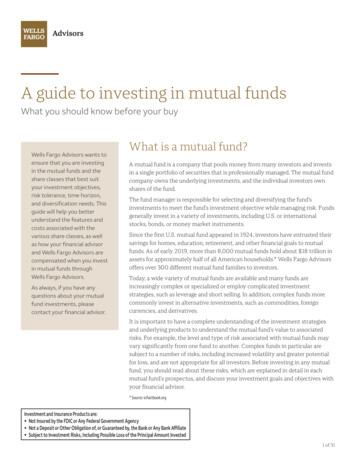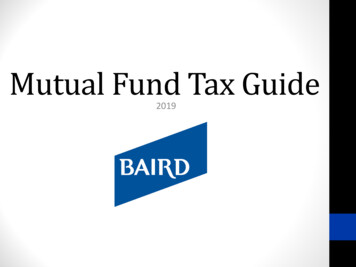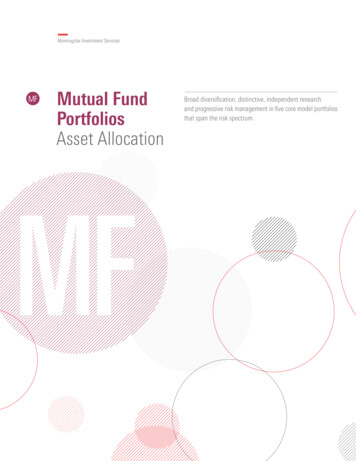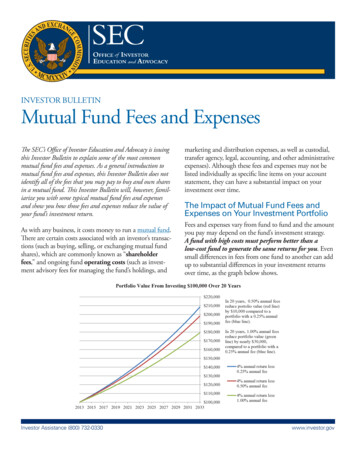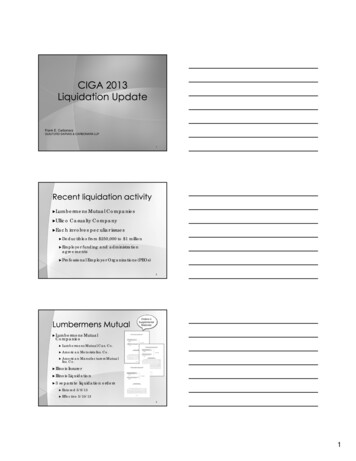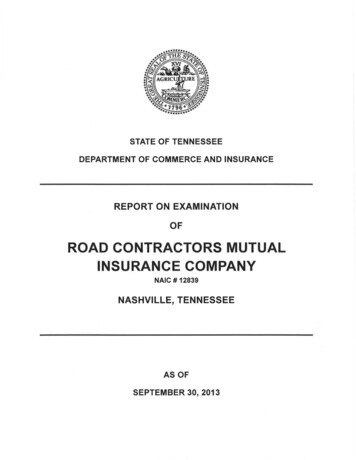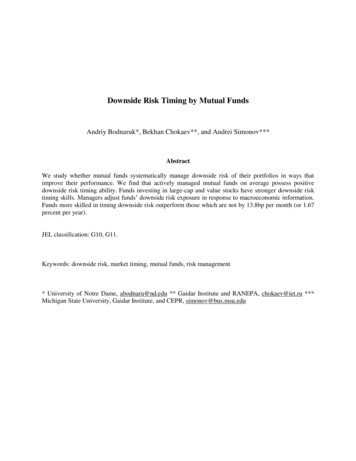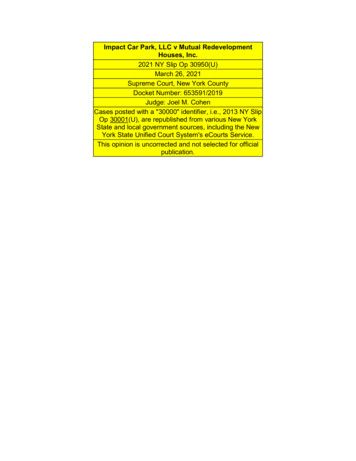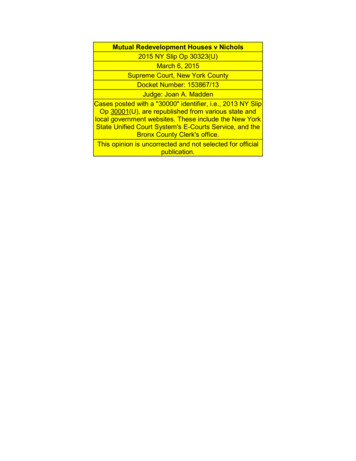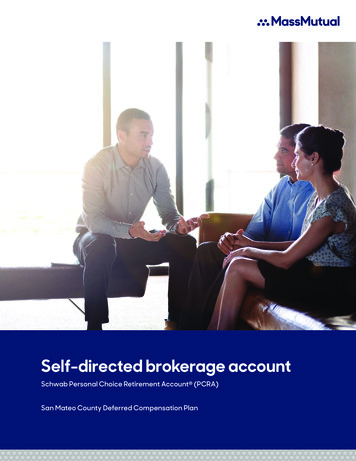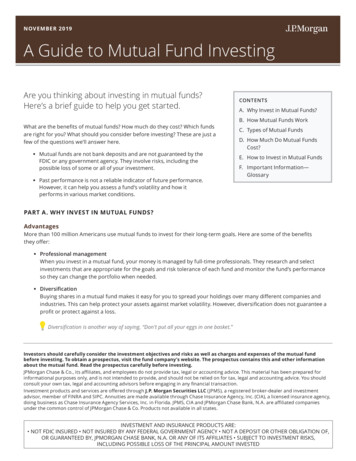
Transcription
NOV EMBER 2 019A Guide to Mutual Fund InvestingAre you thinking about investing in mutual funds?Here’s a brief guide to help you get started.What are the benefits of mutual funds? How much do they cost? Which fundsare right for you? What should you consider before investing? These are just afew of the questions we’ll answer here.§ Mutual funds are not bank deposits and are not guaranteed by theFDIC or any government agency. They involve risks, including thepossible loss of some or all of your investment.§ Past performance is not a reliable indicator of future performance.However, it can help you assess a fund’s volatility and how itperforms in various market conditions.CONTENTSA. Why Invest in Mutual Funds?B. How Mutual Funds WorkC. Types of Mutual FundsD. How Much Do Mutual FundsCost?E. How to Invest in Mutual FundsF. Important Information—GlossaryPART A. WHY INVEST IN MUTUAL FUNDS?AdvantagesMore than 100 million Americans use mutual funds to invest for their long-term goals. Here are some of the benefitsthey offer:§ Professional managementWhen you invest in a mutual fund, your money is managed by full-time professionals. They research and selectinvestments that are appropriate for the goals and risk tolerance of each fund and monitor the fund’s performanceso they can change the portfolio when needed.§ DiversificationBuying shares in a mutual fund makes it easy for you to spread your holdings over many different companies andindustries. This can help protect your assets against market volatility. However, diversification does not guarantee aprofit or protect against a loss.Diversification is another way of saying, “Don’t put all your eggs in one basket.”Investors should carefully consider the investment objectives and risks as well as charges and expenses of the mutual fundbefore investing. To obtain a prospectus, visit the fund company’s website. The prospectus contains this and other informationabout the mutual fund. Read the prospectus carefully before investing.JPMorgan Chase & Co., its affiliates, and employees do not provide tax, legal or accounting advice. This material has been prepared forinformational purposes only, and is not intended to provide, and should not be relied on for tax, legal and accounting advice. You shouldconsult your own tax, legal and accounting advisors before engaging in any financial transaction.Investment products and services are offered through J.P. Morgan Securities LLC (JPMS), a registered broker-dealer and investmentadvisor, member of FINRA and SIPC. Annuities are made available through Chase Insurance Agency, Inc. (CIA), a licensed insurance agency,doing business as Chase Insurance Agency Services, Inc. in Florida. JPMS, CIA and JPMorgan Chase Bank, N.A. are affiliated companiesunder the common control of JPMorgan Chase & Co. Products not available in all states.INVESTMENT AND INSURANCE PRODUCTS ARE: NOT FDIC INSURED NOT INSURED BY ANY FEDERAL GOVERNMENT AGENCY NOT A DEPOSIT OR OTHER OBLIGATION OF,OR GUARANTEED BY, JPMORGAN CHASE BANK, N.A. OR ANY OF ITS AFFILIATES SUBJECT TO INVESTMENT RISKS,INCLUDING POSSIBLE LOSS OF THE PRINCIPAL AMOUNT INVESTED
A GUIDE TO MUTUAL FUND INVES TING§ ChoiceMutual funds give you a wide variety of choices to help meet your financial goals. You can invest for differentobjectives, at different levels of risk and in different kinds of securities. See Part C to learn about different types of mutual funds.§ AffordabilityMutual funds enable you to invest with a relatively small amount of money. Outside of a fund, it would generallyrequire a much larger investment to build such a diversified portfolio.§ LiquidityYou can generally sell your shares at any time and for any reason. However, there may be rare occasions when fundsales are restricted due to extreme market conditions. See Part E for more information about buying and selling shares.§ Automatic reinvestmentMutual funds give you the option of reinvesting your dividends and capital gains in new shares of the fund, withoutincurring a sales charge.You can purchase fractions of a mutual fund share, so every dollar you reinvest goes right back to work in the fund.Important considerationsWhile they have many benefits, mutual funds also have potential issues that investors should consider before decidingto invest:§ RiskAll mutual funds carry some degree of risk. Your investment will go up and down in value. You can lose some or all ofyour money. Your earnings can fluctuate too. See Part C for more information about risks.§ CostRegardless of how a fund performs, you must pay the sales charges, management fees and other expenses of thefund. These costs will reduce your investment returns. See Part D for more information about costs.§ TaxesYou may have to pay taxes on any income or capital gains earned by the fund. This is especially important at the endof the year, when many funds distribute capital gains to investors. See Part E for more information about taxes.§ Lack of transparencyYou will not know the exact holdings of your fund in real time. (Fund holdings are reported with a delay.) Nor will youhave any influence on which investments the fund’s managers buy or sell, or when they buy or sell them.2
A GUIDE TO MUTUAL FUND INVES TINGPART B. HOW MUTUAL FUNDS WORKMutual funds pool money from many investors and invest it in a portfolio of securities, such as stocks or bonds. Each shareof the fund equals a portion of ownership in its holdings and of the income it earns.Here are five things every investor should know about mutual funds:§ Mutual funds are highly regulatedA mutual fund is actually an “investment company” whose purpose is to invest the assets of the fund. All mutual fundsare regulated by the U.S. Securities and Exchange Commission (SEC) to make sure they comply with a strict set of rulesdesigned to protect investors.§ Each fund has a defined objectiveEvery mutual fund strives to achieve a specific investment objective such as long-term growth or current income. Thisobjective is stated in the fund’s fact sheet and prospectus in order to help you choose funds that match your goals. See Part C to learn about different investment objectives.§ Share value is determined dailyMutual fund shares are priced at the end of each business day, based on the net asset value (NAV) of the fund’sholdings. When you sell your shares, you will receive the current NAV minus any applicable sales charge or fees. See Part E for more information about NAV.§ All income is passed through to investorsMutual funds earn income through dividends and interest payments on the securities they hold. This income ispassed on to shareholders (after deductions for expenses) as fund dividends. Shareholders may take fund dividendsas cash or reinvest them in new shares of the fund.Funds may pay dividends monthly, quarterly, semiannually or annually. Fund dividends are taxable as ordinary income.§ Capital gains are passed through to investors tooMutual funds earn capital gains (or losses) when they sell some of their securities. Net gains are passed on toinvestors as capital distributions. Shareholders may take these distributions as cash or reinvest them in new sharesof the fund.Capital distributions are paid annually, usually in December. Distributions are taxable as short-term or long-termcapital gains.PART C. T YPES OF MUTUAL FUNDSDifferent mutual funds offer varying potential for return and risk. In general, funds with the potential for higher returns alsohave higher volatility and greater risk of losing money. Understanding your financial goals and risk tolerance is the first stepin choosing which funds could be right for you.A mutual fund must usually hold at least 80% of its assets in the types of investment suggested by its name.It may also hold up to 20% in other investments. Read the prospectus to see a fund’s specific guidelines.§ Stock (Equity) FundsMany mutual funds invest in stocks, which are also called “equity investments” or “equities” because they are sharesof ownership in a company.– RisksStock funds have higher market risk than bond funds or money market funds, because stock prices can fluctuatedramatically. However, stocks have historically performed better than bonds or other investments over the long term.3
A GUIDE TO MUTUAL FUND INVES TINGThe types of risks a stock fund is subject to will vary by type and are detailed in the fund’s prospectus. The risks astock fund may be subject to include:General Market RiskEconomies and markets throughout the world are becoming increasingly interconnected,which increases the likelihood that events or conditions in one country or region willadversely impact markets or issuers in other countries or regions.Equity Market RiskThe price of equity securities may rise or fall because of changes in the broad market orchanges in a company’s financial condition, sometimes rapidly or unpredictably. These pricemovements may result from factors affecting individual companies, sectors or industries.Smaller CompanyRiskInvestments in securities of smaller companies may be riskier and more volatile andvulnerable to economic, market and industry changes.International RiskInvestments in foreign issuers and securities (including depositary receipts) are subject toadditional risks, including but not limited to, political and economic risks, greater volatility,currency fluctuations, higher transaction costs, and less stringent investor protection anddisclosure standards of foreign markets.Emerging MarketsRiskEmerging market countries typically have less-established market economies and may facegreater social, economic, regulatory and political uncertainties.Currency riskChanges in foreign currency exchange rates will affect the value of a Fund’s securities andthe price of a Fund’s shares.– Investment objectivesStocks can make money for investors in two ways:1. They can grow in value when their share prices increase.2. They can earn income through stock dividends paid by the company.Stock funds that focus on companies with rising share prices are called “growth” or “capital appreciation” funds. Fundsthat seek to make money from stock dividends as well as rising share prices are called “growth and income” or “equityincome” funds.Growth funds are generally considered riskier because they invest in companies that may not pay dividends.Growth-and-income funds try to reduce risk by combining growth with a steadier source of return through dividends.– Types of stock fundsThere are thousands of funds investing in every corner of the stock market all over the world. These are somecommon stock funds:Large cap fundsInvest in larger companiesSmall cap fundsInvest in smaller companiesInternational fundsInvest in non-U.S. companiesGlobal fundsInvest in both U.S. and non-U.S. companiesSector fundsInvest in specific kinds of industries, such as technology or consumer products4
A GUIDE TO MUTUAL FUND INVES TING§ Bond (Fixed Income) FundsMutual funds that invest in interest-paying securities are called bond funds or fixed income funds. Interest is passedthrough to investors (minus fund expenses) and is called the fund’s yield. Bond funds are popular with investors whoseek regular income or to balance their stock investments with more conservative funds.– RisksWhile bond funds may be less volatile than stock funds, they are still subject to several kinds of risk, including:Credit riskThe risk that the bond’s issuer may default on its debtsInterest rate riskThe risk that bond prices will go down when interest rates riseInflation riskThe risk that inflation will reduce the purchasing power of the fund’s dividendsCall riskThe risk that bonds in the portfolio will be called (bought back by the issuer) and replacedwith lower-paying bondsReinvestment riskThe risk that fund dividends will be reinvested at a lower interest rateEvent riskThe risk that mergers, acquisitions, restructurings or other events will affect the issuer’screditworthinessCurrency riskThe risk that foreign bonds will be negatively affected by changes in exchange ratesBond funds—unlike the bonds they hold—do not pay fixed rates or have a maturity date. Your income from a bondfund will fluctuate, and there is no guarantee you will get your original investment back when you sell your shares.– Investment objectivesSome bond funds focus on “current income” by seeking to maximize yields while minimizing price fluctuations.Others invest for “total return” from the combination of current income plus capital gains from rising bond prices.– Types of bond fundsYou can find bond funds investing in many different kinds of interest-paying securities. Some of the most commonfunds invest in corporate bonds, government bonds, tax-exempt municipal bonds, high yield bonds, intermediateterm bonds, short-term bonds, global bonds or emerging markets bonds issued by developing countries.§ Multi-Asset FundsThere are several kinds of funds that combine stocks, bonds and other securities in one portfolio:– “Balanced” or “asset allocation” funds diversify their portfolios across stocks, bonds and cash.– “Target-date” or “life cycle” funds change their allocation to become more conservative as you get older and closerto retirement.– “Flexible” or “unconstrained” funds have a broad mandate to invest in a wide range of securities.§ Index FundsInstead of researching and selecting individual securities, index funds seek to mimic the composition and theperformance of an entire market index, such as the S&P 500 index of large cap stocks. Index funds, also called“passive funds,” usually have lower expenses than actively managed funds have. You can find index funds that investin a wide variety of stock, bond and other indexes.The returns of an index fund are calculated net of the fund’s expenses, unlike the index itself, which does notinclude any management fees or other costs.5
A GUIDE TO MUTUAL FUND INVES TING§ Non-Traditional FundsInstead of long-term investing in traditional stocks or bonds, some mutual funds follow alternative investmentstrategies. These funds may pursue complex trading strategies such as short-selling or using options and futures,or invest in nontraditional asset classes such as commodities or real estate securities. These funds may also useleverage (borrowed money) to increase their potential returns, which also increases their risk. See Investing inNon-Traditional Funds for additional information.Not all investment funds are mutual funds. Hedge funds, venture capital funds, exchange-traded funds,closed end funds and unit investment trusts are NOT mutual funds and are not subject to the same rulesand regulations.§ Money Market FundsThese funds seek to pay higher interest than bank accounts do while maintaining a consistent value of 1 per share.However, they are not bank accounts, not FDIC-insured and not guaranteed to maintain their value.In 2016, the SEC adopted reforms to reduce the potential risks to money market funds. During extreme marketvolatility, money market funds may now impose:– “Redemption gates” that could temporarily prevent you from selling your shares– “Liquidity fees” that could charge up to 2% for selling your sharesFund companies must designate money market funds (at the fund family level) as retail, institutional or government.Retail money market funds have policies and procedures reasonably designed to limit all beneficial owners to “naturalpersons” (e.g. individuals, but not corporations).Institutional money market funds (but not retail funds) may also impose a “floating NAV” that would allow the value ofits shares to fluctuate in extreme conditions.These reforms do not apply to government money market funds, unless they disclose this to you in the prospectus.PART D. HOW MUCH DO MUTUAL FUNDS COST ?Like any business, mutual funds have expenses. These costs are passed through to investors. It’s important to understandthese costs, because they will affect your investment returns.§ Sales chargesSome mutual funds charge a fee to purchase shares, which is paid when you buy or sell the fund. A portion of this feeis usually paid to your financial advisor. Sales charges vary for different share classes. See Part E for more information about share classes.§ Front-end loadWhen mutual funds charge an upfront fee to buy shares, it’s called a “front-end load.” It is deducted from thepurchase price, and reduces the amount of your initial investment. This charge typically applies to Class A shares.§ Back-end loadInstead of a front-end load, you can buy some mutual funds with a contingent deferred sales charge (CDSC), called a“back-end load.” This fee is charged when you sell your shares. The amount is reduced over time, and usually becomeszero after a period of years. It typically applies to Class B and C shares.§ Exchange feesIf you transfer your shares from one fund to another within the same fund group, you may be charged an exchangefee. In some cases, these fees are waived.6
A GUIDE TO MUTUAL FUND INVES TING§ Operating expensesThe ongoing costs of running a fund are called its operating expenses. The fund company pays these expenses from thefund’s assets before distributing any earnings to investors, which reduces the net returns of the fund.It’s easy to find out the operating costs of a fund by looking at its “expense ratio,” which is disclosed on everyfund’s fact sheet and prospectus. The expense ratio is the fund’s total annual operating costs as a percentageof its assets.§ Management feeThe largest cost of running a fund is usually the management fee paid to its investment advisor for researching andselecting securities in the portfolio, as well as some administrative expenses.§ 12b-1 (distribution and service) feesThese fees cover the cost of marketing and selling fund shares and providing shareholder services, such as advertising,running phone centers, and printing and mailing prospectuses. A portion of this fee may be paid to the brokerage firmthat distributes the fund, and another portion may be paid to your financial advisor. Class B and C shares usually havehigher 12b-1 fees than Class A shares.§ Other expensesOther costs, such as legal and accounting services, custody, transfer agency, and administration, are also included inthe fund’s operating expenses.§ Revenue sharingSome mutual funds or affiliated entities pay a portion of their revenue to the brokerage firm that distributes the fund toinvestors. These payments come out of the entity’s revenues or profits and are not charged separately to investors. J.P.Morgan Securities LLC (JPMS) receives these payments from some mutual fund advisors, distributors or other entities,based on the amount of shares sold by JPMS or owned by JPMS’s clients. Your financial advisor does not get paid aportion of this revenue.PART E. HOW TO INVEST IN MUTUAL FUNDS§ Buying and sellingMutual funds may be purchased or “redeemed” (sold back to the company) at the “net asset value” (NAV) per share,calculated after you place your order. The NAV is the total value of the fund’s holdings divided by the number of shares.It is calculated every business day at the time listed in the prospectus—usually 4PM Eastern Time, when the New YorkStock Exchange closes. Applicable fees and sales charges, if any, are added to your purchase price or deducted fromyour sale price.If your order is received after the cutoff time, or while the markets are closed, it will be priced on the next business day.§ Restrictions on short-term investorsMost mutual funds are designed to help long-term investors meet their financial goals over time. They may notbe suitable for investors seeking quick profits or to “time the market” through active trading. To protect othershareholders, some funds have implemented policies to discourage excessive trading.Rapid buying and selling can harm other shareholders by disrupting the fund’s investment strategy, increasing tradingcosts or causing the fund’s managers to keep more
A mutual fund is actually an “investment company” whose purpose is to invest the assets of the fund. All mutual funds are regulated by the U.S. Securities and Exchange Commission (SEC) to make sure they comply with a strict set of rules designed to protect investors. § Each fund has a de 4ned objective
